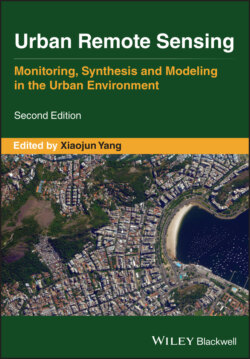Читать книгу Urban Remote Sensing - Группа авторов - Страница 38
2.4.2.2.1 Initial SAR Findings
ОглавлениеBackscatter data can be combined and averaged from multiple SAR scenes to account for both ascending and descending observations as well as for noise reduction. Each backscatter ensemble is made over the 2D areal extent of building footprints on the land surface, for which remote sensing products are available such as the Global Urban Footprint (Esch et al. 2013, 2017, 2018). Initial results for Hồ Chí Minh City and its surroundings derived from CSK SAR data at 3 m spatial resolution (Nghiem and Science Team 2019) could detect complex of large building in District 1 in the city center on west side of the Saigon River while a mostly bare field was found in Thủ Thiêm on the east side of the river where the land was cleared but buildings have yet to be constructed. Other work supports the use of these data for 2D build‐up (i.e. extent, density) monitoring and characterization (e.g. Strozzi and Wegmuller 1998; Thiele et al. 2007; Brenner and Roessing 2008; Schmidt et al. 2010; Esch et al. 2011; Leinenkugel et al. 2011; Wu et al. 2011; Marin et al. 2015; Sorichetta et al. 2020) as well as 3D feature characterization (e.g. Soergel et al. 2003; Brunner et al. 2010; Buckreuss et al. 2018; Qiu et al. 2018) – for example, TDX data were employed for urban footprint delineation (Taubenböck et al. 2012) and to examine forest vegetation height (Qi and Dubayah 2016). In evaluating the utility of a variety of geospatial datasets for urban build‐up at a continentalscale, Li et al. (2020) found SAR data to be the most useful for estimating building height, which further attests to the significance of SAR data for 3D urban analyses.
Complex SAR data (including both real and imaginary parts in complex‐variable numbers, or magnitude and phase in the phasor form) can be used for urban building detection using time‐paring complex coherence method (Paloscia et al. 2019) together with geometricmean multi‐temporal coherence method from multiple CSK SAR scenes over urban areas (Nghiem and Science Team 2019) showing building density on the land surface not only within the city but also over small villages and minor settlements along roads. The Tân Sơn Nhất International Airport with a large area of runways was also clearly identified. Nghiem and Science Team (2019) detected houses built on the other side of the Yên Phụ levee directly adjacent to the waterway of the Red River in Hanoi, Vietnam. While multiple SAR datasets can be used synergistically to have more extensive and frequent observations of urban areas, cross‐validation of SAR data will be necessary to obtain consistent results for long‐term monitoring of urban built‐up change.
